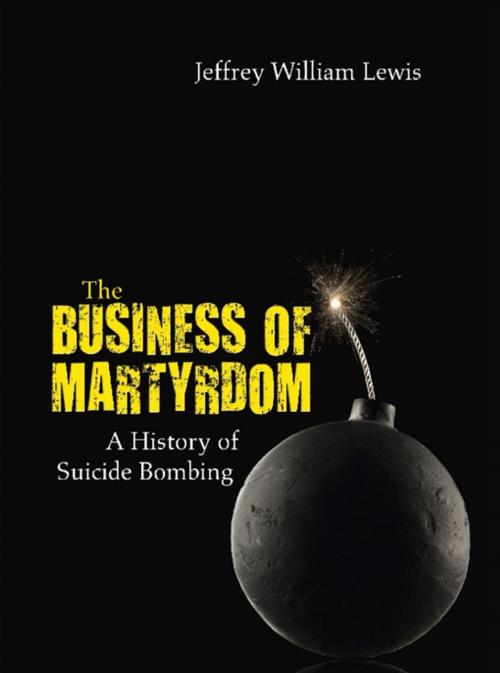The Business of Martyrdom
A History of Suicide Bombing
Nonfiction, Social & Cultural Studies, Political Science| Author: | Jeffrey William Lewis | ISBN: | 9781612510972 |
| Publisher: | Naval Institute Press | Publication: | April 15, 2012 |
| Imprint: | Naval Institute Press | Language: | English |
| Author: | Jeffrey William Lewis |
| ISBN: | 9781612510972 |
| Publisher: | Naval Institute Press |
| Publication: | April 15, 2012 |
| Imprint: | Naval Institute Press |
| Language: | English |
The Business of Martyrdom is the only comprehensive history of suicide bombing from its origins in Imperial Russia to the present day. It makes use of a framework from the history and philosophy of technology to explain the diffusion and evolution of suicide bombing over the past several decades. It is primarily a work of synthesis meant to reach a broad audience and endeavors to integrate as much of the recent scholarly literature as possible, including reconciling explanatory mechanisms that seem to be at odds with one another. In addition, this book is able to draw on very recent changes in suicide bombing in the years 2008-2010 that allow it to have a slightly different perspective than earlier studies. For the first time the global number of suicide attacks has declined significantly for three years in a row. This book therefore has the advantage of addressing the phenomenon of suicide bombing as a bounded phenomenon with limits to its growth and diffusion.
To this point the impression that suicide bombers are the smartest bombs yet created has been widespread but confined to the area of metaphor. Drawing well-established ideas from the history of technology, The Business of Martyrdom argues that the metaphor should be taken literally. Suicide bombing is a technology that has been invented and re-invented at different times in different areas but always for the same purpose: resolving a mismatch in military capabilities between antagonists by utilizing the available cultural and human resources.
Over the past several years, analysts have produced a large number of monographs and articles examining suicide bombing. The best contributions in this new and growing literature have shed considerable light on the complexity of suicide bombing in practice, particularly regarding the structure of the organizations that deploy suicide bombers and the relationships between these organizations and the recruits whom they utilize in their attacks. Nevertheless, nagging inconsistencies and questions remain. These inconsistencies can be explained by examining suicide bombing as a technological system that integrates human beings, cultures, and devices and directs them toward specific ends. Such an analysis requires that neither the individual bombers nor their sponsoring organizations be the basic unit of discussion. Instead, the bombers must be understood as components within a much larger system that has been shaped by a host of social, cultural, and operational constraints throughout its existence. Integrating insights from the historical analysis of other technological systems with the recent literature specifically devoted to suicide bombing therefore allows The Business of Martyrdom to develop a fuller understanding of suicide bombing as a unified yet diverse phenomenon
To this point the impression that suicide bombers are the smartest bombs yet created has been widespread but confined to the area of metaphor. Drawing well-established ideas from the history of technology, The Business of Martyrdom argues that the metaphor should be taken literally. Suicide bombing is a technology that has been invented and re-invented at different times in different areas but always for the same purpose: resolving a mismatch in military capabilities between antagonists by utilizing the available cultural and human resources.
Over the past several years, analysts have produced a large number of monographs and articles examining suicide bombing. The best contributions in this new and growing literature have shed considerable light on the complexity of suicide bombing in practice, particularly regarding the structure of the organizations that deploy suicide bombers and the relationships between these organizations and the recruits whom they utilize in their attacks. Nevertheless, nagging inconsistencies and questions remain. These inconsistencies can be explained by examining suicide bombing as a technological system that integrates human beings, cultures, and devices and directs them toward specific ends. Such an analysis requires that neither the individual bombers nor their sponsoring organizations be the basic unit of discussion. Instead, the bombers must be understood as components within a much larger system that has been shaped by a host of social, cultural, and operational constraints throughout its existence. Integrating insights from the historical analysis of other technological systems with the recent literature specifically devoted to suicide bombing therefore allows The Business of Martyrdom to develop a fuller understanding of suicide bombing as a unified yet diverse phenomenon
The Business of Martyrdom is the only comprehensive history of suicide bombing from its origins in Imperial Russia to the present day. It makes use of a framework from the history and philosophy of technology to explain the diffusion and evolution of suicide bombing over the past several decades. It is primarily a work of synthesis meant to reach a broad audience and endeavors to integrate as much of the recent scholarly literature as possible, including reconciling explanatory mechanisms that seem to be at odds with one another. In addition, this book is able to draw on very recent changes in suicide bombing in the years 2008-2010 that allow it to have a slightly different perspective than earlier studies. For the first time the global number of suicide attacks has declined significantly for three years in a row. This book therefore has the advantage of addressing the phenomenon of suicide bombing as a bounded phenomenon with limits to its growth and diffusion.
To this point the impression that suicide bombers are the smartest bombs yet created has been widespread but confined to the area of metaphor. Drawing well-established ideas from the history of technology, The Business of Martyrdom argues that the metaphor should be taken literally. Suicide bombing is a technology that has been invented and re-invented at different times in different areas but always for the same purpose: resolving a mismatch in military capabilities between antagonists by utilizing the available cultural and human resources.
Over the past several years, analysts have produced a large number of monographs and articles examining suicide bombing. The best contributions in this new and growing literature have shed considerable light on the complexity of suicide bombing in practice, particularly regarding the structure of the organizations that deploy suicide bombers and the relationships between these organizations and the recruits whom they utilize in their attacks. Nevertheless, nagging inconsistencies and questions remain. These inconsistencies can be explained by examining suicide bombing as a technological system that integrates human beings, cultures, and devices and directs them toward specific ends. Such an analysis requires that neither the individual bombers nor their sponsoring organizations be the basic unit of discussion. Instead, the bombers must be understood as components within a much larger system that has been shaped by a host of social, cultural, and operational constraints throughout its existence. Integrating insights from the historical analysis of other technological systems with the recent literature specifically devoted to suicide bombing therefore allows The Business of Martyrdom to develop a fuller understanding of suicide bombing as a unified yet diverse phenomenon
To this point the impression that suicide bombers are the smartest bombs yet created has been widespread but confined to the area of metaphor. Drawing well-established ideas from the history of technology, The Business of Martyrdom argues that the metaphor should be taken literally. Suicide bombing is a technology that has been invented and re-invented at different times in different areas but always for the same purpose: resolving a mismatch in military capabilities between antagonists by utilizing the available cultural and human resources.
Over the past several years, analysts have produced a large number of monographs and articles examining suicide bombing. The best contributions in this new and growing literature have shed considerable light on the complexity of suicide bombing in practice, particularly regarding the structure of the organizations that deploy suicide bombers and the relationships between these organizations and the recruits whom they utilize in their attacks. Nevertheless, nagging inconsistencies and questions remain. These inconsistencies can be explained by examining suicide bombing as a technological system that integrates human beings, cultures, and devices and directs them toward specific ends. Such an analysis requires that neither the individual bombers nor their sponsoring organizations be the basic unit of discussion. Instead, the bombers must be understood as components within a much larger system that has been shaped by a host of social, cultural, and operational constraints throughout its existence. Integrating insights from the historical analysis of other technological systems with the recent literature specifically devoted to suicide bombing therefore allows The Business of Martyrdom to develop a fuller understanding of suicide bombing as a unified yet diverse phenomenon















